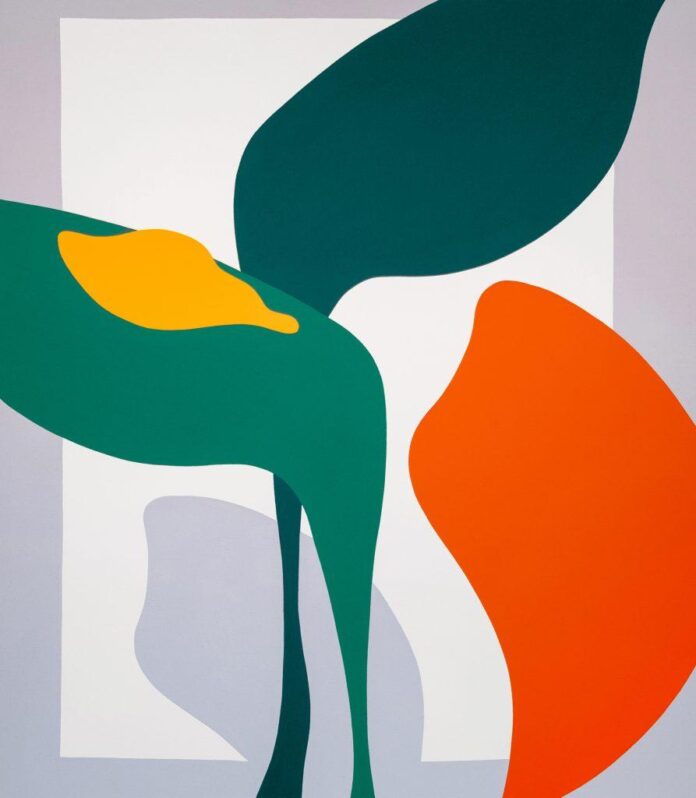From its title, “Blooms,” Paul Kremer’s latest series of paintings, which will anchor his new exhibition at Library Street Collective, seems every bit organic in name, subject, and nature. Featuring abstract variations of flowers, each biotic in form and bold in color, the canvases recall Color Field hallmarks as much as Henri Matisse’s cut-outs—squaring with and expanding on the Houston-based artist’s visual language.
But while these “Blooms” were created with his standard tools—paints, paintbrush, canvas—Kremer also had in his corner a new collaborator: ChatGPT, the A.I. large language model.
“I wanted a fast way to manipulate shapes and color palettes,” he told Artnet News. “I realized that ChatGPT could help me brush up on my basic coding skills, allowing me to develop a suite of online tools to import drawings and color palettes, and generate new ideas.”

Installation view of “Paul Kremer: Spring” at Library Street Collective. Photo: PD Rearick, courtesy of Library Street Collective.
Developed by OpenAI, ChatGPT, in its most recent iteration, GPT-3, has been made relatively accessible as a conversational A.I. platform. The model has been trained on a massive corpus of text data scraped from the internet, which means users can interact with it to source answers to burning questions or, more often than not, to generate natural language material, from high-school essays to rap lyrics.
Kremer leveraged the model’s generative capabilities in the exploratory phase of “Blooms,” getting it to produce changeable compositions based on inputs of various shapes and colors. To facilitate this process, he teamed up with artist and programmer Leander Herzog to develop software that would enable him to easily feed, randomize, and manipulate the model’s outputs.

Paul Kremer, Bloom 09 (2023). Photo courtesy of the artist’s studio and Library Street Collective
Using the customized software, he said, “I can select and manipulate individual shapes from various sets of random shapes and adjust their position, size, and rotation. I can drag and drop colors onto these shapes and even randomize colors derived from my own color palettes.”
These experiments would then inspire new approaches to his latest series of paintings. “The outcomes often surprise me and spur on new ideas,” he added. “I save and refine these files, then redraw and paint them on canvas.”
The use of digital tools as part of a creative process—and even creating those tools through the process, as in the case with “Blooms”—befits a self-taught artist with a background in web design. But more so, it builds on the conceptual framework that has informed Kremer’s creative practice.

Installation view of “Paul Kremer: Spring” at Library Street Collective. Photo: PD Rearick, courtesy of Library Street Collective.
Born in 1971, Kremer has been noted for his Minimalist abstractions of everyday forms in paintings that maximize color to channel expressive and lively immediacy. His artistic work, which he began in the 2010s, has not been without digital intervention, whether through his use of Google image searches or photoshop manipulations. (For what it’s worth, Kremer is also behind the wildly viral Tumblr site, Great Art in Ugly Rooms.)
“Making tools based off of my paintings to create variations of those paintings has been a part of my past and will always be a part of what I do,” he said. “I don’t want my art to be stuck in either the digital or physical world. I see the idea of both feeding off of each other as my art.”
That Kremer has now availed himself of A.I. makes sense considering the explosive popularity of the technology and with it, generative art. His use, he clarified, is strictly that of an “art-making tool,” as opposed to an art-generating machine.
He explained: “I am not asking [the A.I.] to create paintings in my style; I’m asking it to display my art in certain ways so that I can manipulate it.”

Installation view of “Paul Kremer: Spring” at Library Street Collective. Photo: PD Rearick, courtesy of Library Street Collective.
While there’s been a growing chorus of voices against A.I., which Kremer characterizes as “a certain fear / dismissiveness / snobbishness” toward the technology, for him, there remains creative potential in “using new tools for otherwise ancient practices.”
He points to a round silicone coaster he owns, which could be bent into different shapes to cast interesting shadows—certainly visual fodder for one of his canvases.
“I want to create a digital tool that helps me instantly visualize many variations of that. I might paint these images or even recreate these forms into large-scale silicone sculptures that people can manipulate themselves,” he said. “How do I do that? Why not start with A.I.?”
“Paul Kremer: Spring” is on view at Library Street Collective, 1274 Library Street, Detroit, March 4–April 26, 2023.

























